13.6 Diseases and Disorders of the Skeletal System
This section will discuss common diseases and disorders of the skeletal system.
Abnormal Curvatures of the Spine
The vertebral column normally has curvatures, but abnormal or excessive curvatures can develop due to diseases and disorders of the spine. Disorders associated with the curvature of the spine include scoliosis, kyphosis, and lordosis[1]:
- Scoliosis (skō-lē-Ō-sĭs): Scoliosis is an abnormal, lateral curvature, accompanied by twisting of the vertebral column. See Figure 13.22a for an illustration of scoliosis. Scoliosis is the most common vertebral abnormality among girls. When present, scoliosis tends to worsen during adolescent growth spurts. A back brace may be recommended for growing children with scoliosis, and in severe cases, surgery may be required.
- Kyphosis (kī-FŌ-sĭs): Kyphosis, commonly referred to as humpback, is an excessive posterior curvature of the thoracic region. This can develop when osteoporosis causes weakening and erosion of the anterior portions of the upper thoracic vertebrae, resulting in their gradual collapse. See Figure 13.22b for an illustration of kyphosis.
- Lordosis (lor-DŌ-sĭs): Lordosis, commonly referred to as swayback, is an excessive anterior curvature of the lumbar region and is most commonly associated with obesity or late pregnancy. See Figure 13.22c[2] for an illustration of lordosis. The accumulation of weight in the abdominal region results in an anterior shift in the line of gravity that carries the weight of the body. This causes an anterior tilt of the pelvis and a pronounced enhancement of the lumbar curve.
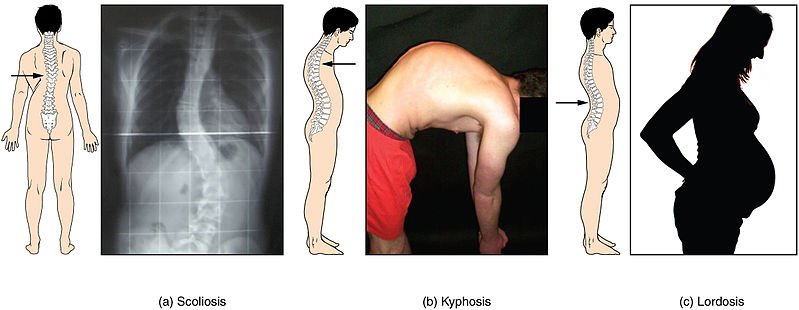
Arthritis
Common types of arthritis (är-THRĪ-tĭs) are osteoarthritis (OA), rheumatoid arthritis (RA), and gout. Read more about these conditions in the corresponding subsections.
Bone Cancer
There are three types of primary bone cancers: osteosarcoma, Ewing sarcoma, and chondrosarcoma. These are considered primary cancers because they originate in the bones. Osteosarcoma and Ewing sarcomas are cancers found in children, teenagers, and young adults. Ewing sarcoma is considered to be the more aggressive of the two cancers because it tends to metastasize quickly. Osteosarcoma is the most common type of bone cancer, and it begins in the tissues of growing bones. Chondrosarcoma develops in cells that produce cartilage and affects adults. Symptoms of bone cancer may include fatigue, unintended weight loss, bone pain, swelling, tenderness, and weakened bone leading to fractures. Diagnostic testing may include a bone scan, X-ray, CT scan, MRI, PET scan, and bone biopsies. Treatment is based on the type of cancer, the stage of the cancer, and the patient’s overall health and preferences. For example, some bone cancers are treated with surgery; some are treated with surgery and chemotherapy; and others are treated with surgery, chemotherapy, and radiation therapy.[3]
Carpal Tunnel Syndrome
Carpal tunnel syndrome is a disorder that occurs when the median nerve, which runs from the forearm into the palm of the hand, becomes pressed or squeezed at the wrist. Read more information about carpal tunnel syndrome in the “Diseases and Disorders Related of the Nervous System.”
Fracture
A fracture (FRĂK-chŭr) (fx) is a broken bone. It will heal automatically due to the action of osteoclasts and osteoblasts, but if the bone is not reset and aligned correctly, it will remain in a dislocated position. Fractures are classified by their complexity, location, and other features. Some fractures may be described using more than one term (e.g., an open transverse fracture) because it may have the features of more than one type. See Figure 13.23[4] for an illustration of different types of fractures that include the following[5]:
- Closed or simple (klōzd ōr sĭm-pŭl frăk-chŭr): Bone is broken but does not protrude the skin
- Open or compound (ō-pĕn ōr kŏm-pound frăk-chŭr): Bone is broken and pierces through the skin
- Transverse (trăns-vûrs): Bone is broken straight across
- Spiral (spī-răl): Bone has twisted apart
- Comminuted (kŏm-ĭ-nū-tĕd): A bone is crushed into pieces
- Impacted (ĭm-păk-tĕd): One fragment of the bone is driven into the other, usually as a result of compression
- Greenstick (grēn-stĭk): Bone is partially broken, a condition that occurs in children
- Oblique (ō-blēk): Bone is broken at an angle
- Stress (strĕs): Small crack in a bone
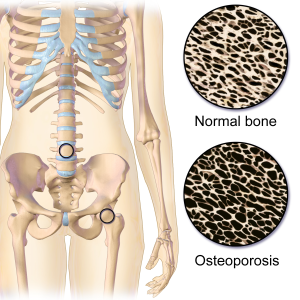
Gout
Gout (gowt) is a type of inflammatory arthritis that causes pain and swelling in the joints, usually as flares that last for one or two weeks and then resolve. Gout flares often begin in the big toe or a lower limb. Gout occurs when high levels of serum uric acid build up in the body, which can form needle-shaped crystals in and around the joint and cause inflammation. Uric acid is a waste product produced by the breakdown of purine, a type of molecule found in many foods we eat. Gout is diagnosed with blood tests for uric acid. It is commonly treated with medications like nonsteroidal anti-inflammatories (NSAIDs) and colchicine.[6] See Figure 13.24[7] for an illustration of gout.
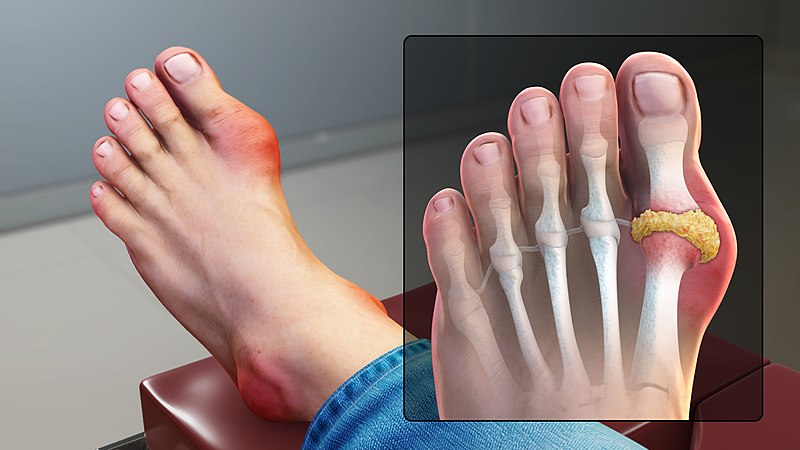
Lupus
Systemic lupus erythematosus (sĭs-tĕm-ĭk lū-pŭs ĕr-ĕth-ĕm-ă-tō-sŭs), commonly referred to as lupus (lū-pŭs), is a chronic autoimmune disease that can affect many parts of the body. Lupus occurs when the immune system attacks its own tissues, causing inflammation and in some cases permanent tissue damage. Tissue damage can be widespread and affect the joints, skin, heart, lung, kidneys, blood cells, and brain.[8]
The symptoms of lupus vary from person to person. They can range from mild to severe, and they may come and go. Common symptoms can include arthritis, fatigue, and a classic rash that appears on the face across the nose and cheeks called a “butterfly rash.” See Figure 13.25[9] for an image of a butterfly rash associated with lupus. No single test can be used to diagnose lupus, but a blood test called antinuclear antibodies (ANA) may be performed. There is no cure for lupus, but medications are prescribed to manage inflammation, and immunosuppressants may be used to curb the overactive immune system.[10]
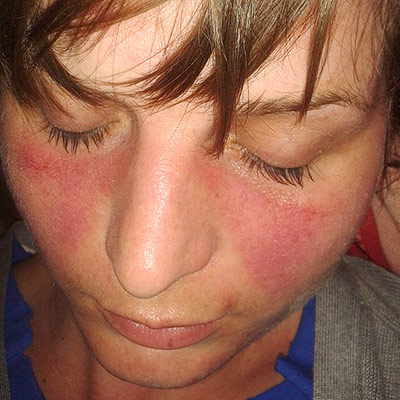
Osteoarthritis
Osteoarthritis (ŏs-tē-ō-är-THRĪ-tĭs) is a degenerative joint disease in which the tissues in the joint break down over several years. It is the most common type of arthritis and frequently occurs as people age. People with osteoarthritis usually have joint pain or stiffness after rest or inactivity for a short period of time. The most commonly affected joints include the hands, knees, hips, neck, and lower back. See Figure 13.26[11] for an image of a person with osteoarthritis in their finger. Osteoarthritis affects each person differently. For some people, osteoarthritis is relatively mild and does not affect day-to-day activities. For others, it causes significant pain and disability.[12]
Crepitus (krĕp-ĭ-tŭs) describes a popping, clicking, or crackling sound when moving a joint that is associated with osteoarthritis. It typically reflects air movement in the joint and is harmless.[13]
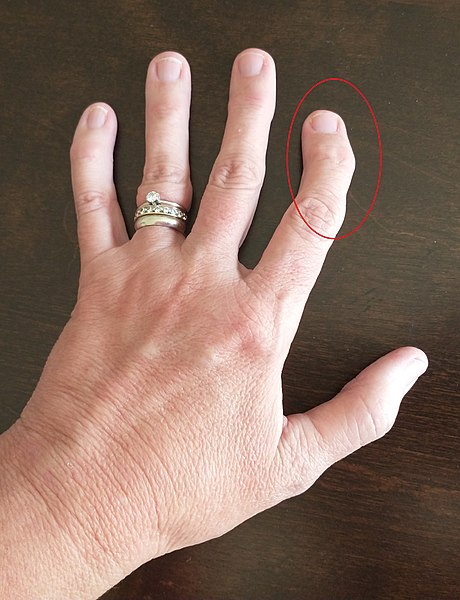
Osteoarthritis is initially treated with lifestyle changes like exercise and weight management. Braces may be used to support the affected joints. Oral and topical pain relievers may be prescribed. If joint damage is severe, joint replacement surgery may be required.[14]
Osteomyelitis
Osteomyelitis (ŏs-tē-ō-mī-ĕ-LĪT-ĭs) is an infection in a bone. Infections can reach a bone by traveling through the bloodstream or spreading from nearby tissue. Infections can also begin in the bone itself if an injury exposes the bone to bacteria. Smokers and people with chronic health conditions, such as diabetes or kidney failure, are at higher risk of developing osteomyelitis. People who have diabetes may develop osteomyelitis in their feet if they develop foot ulcers. Although once considered incurable, osteomyelitis can now be successfully treated with surgery and strong intravenous antibiotics.[15]
Osteopenia and Osteoporosis
Osteopenia (os-tē-ō-PĒ-nē-ă) is an abnormal reduction of bone mass that can lead to osteoporosis. Osteoporosis (ŏs-tē-ō-pō-RŌ-sĭs) is a condition where the bones become weak and brittle. Osteoporosis increases the risk of fractures and can also cause kyphosis as vertebrae gradually collapse. See Figure 13.27[16] for an illustration of osteoporosis resulting in kyphosis. Osteoporosis is a “silent” disease because people typically do not have symptoms and do not know they have the disease until they break a bone. Osteoporosis is the major cause of fractures in postmenopausal women and in older men. Fractures due to osteoporosis can occur in any bone but happen most frequently in bones of the hip, vertebrae, and wrist.[17] See Figure 13.27 for an illustration of osteoporosis compared to normal bone in the hip and spine.
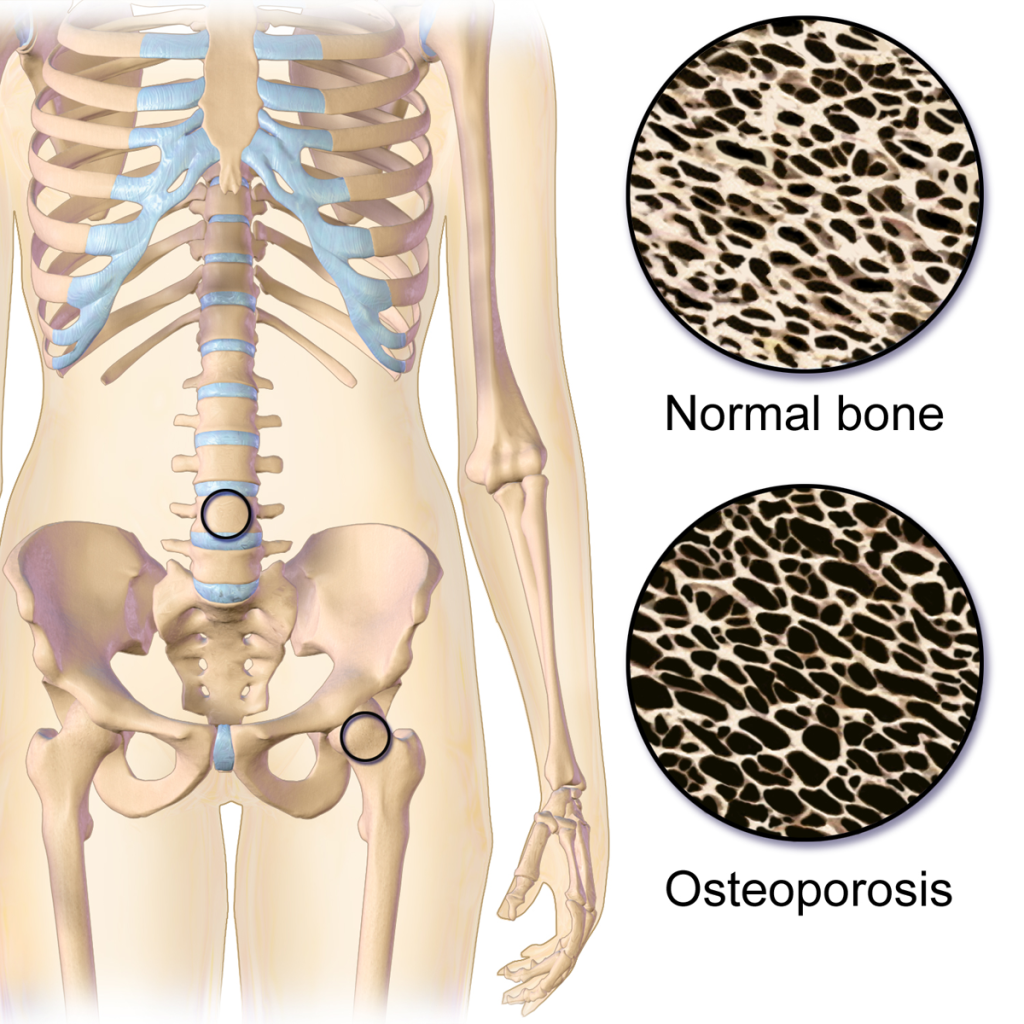
The most common test for measuring bone mineral density is dual-energy X-ray absorptiometry (DEXA scan). Read more about this test in the “Medical Specialists, Diagnostic Testing, and Procedures Related to the Skeletal System” section of this chapter. Lifestyle changes like weight-bearing exercise and a nutritious diet rich in calcium and vitamin D can help prevent and treat osteoporosis. Medications that enhance bone density and strength are generally prescribed for people with osteoporosis.[18]
Rheumatoid Arthritis
Rheumatoid arthritis (rū-mă-toid är-thrī-tĭs) (RA) is a chronic autoimmune disease that affects the joints. RA occurs in a symmetrical pattern, meaning that if one knee or hand has the condition, the other hand or knee is also affected. It can affect the joints in the wrists, hands, elbows, shoulders, feet, spine, knees, and jaw. RA causes pain, swelling, stiffness, deformity, and loss of function. See Figure 13.28[19] for an illustration of rheumatoid arthritis in the hands causing a common “swan-like” deformity.[20]
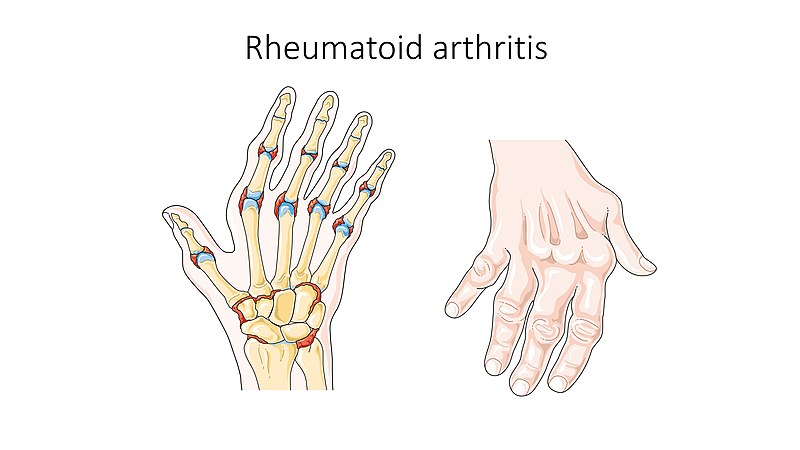
Rheumatoid arthritis may be diagnosed with blood tests like rheumatoid factor or anti-CCP antibodies. It is treated with medications, physical and occupational therapy, and in some cases, joint repair or replacement.[21]
Rickets
Rickets (RĬK-ĭts) is a disease in children caused by extreme and prolonged vitamin D deficiency, characterized by softening and distortion of the bones. It typically results in a bow-legged appearance. See Figure 13.29[22] for an image of children with rickets.

- This work is a derivative of Anatomy & Physiology by OpenStax and is licensed under CC BY 4.0. Access for free at https://openstax.org/details/books/anatomy-and-physiology-2e ↵
- “717_Abnormal_Curves_of_Vertebral_Column.jpg ” by OpenStax College is licensed under CC BY 3.0 ↵
- Mayo Clinic. (2023, May 11). Bone cancer. https://www.mayoclinic.org/diseases-conditions/bone-cancer/symptoms-causes/syc-20350217 ↵
- “612_Types_of_Fractures.jpg” by OpenStax College is licensed under CC BY 4.0 ↵
- This work is a derivative of Anatomy & Physiology by OpenStax and is licensed under CC BY 4.0. Access for free at https://openstax.org/details/books/anatomy-and-physiology-2e ↵
- National Institute of Arthritis and Musculoskeletal and Skin Diseases. (2020, February). Gout. National Institutes of Health. https://www.niams.nih.gov/health-topics/gout ↵
- “Gout_Signs_and_Symptoms.jpg” by www.scientificanimations.com is licensed under CC BY-SA 4.0 ↵
- National Institute of Arthritis and Musculoskeletal and Skin Diseases. (2022, October). Systemic lupus erythematosus (lupus). National Institutes of Health. https://www.niams.nih.gov/health-topics/lupus ↵
- “Lupusfoto.jpg” by Doktorinternet is licensed under CC BY-SA 4.0 ↵
- National Institute of Arthritis and Musculoskeletal and Skin Diseases. (2022, October). Systemic lupus erythematosus (lupus). National Institutes of Health. https://www.niams.nih.gov/health-topics/lupus ↵
- “Osteoarthritis_in_the_left_hand_index_finger.jpg” by Whoisjohngalt is licensed under CC BY-SA 4.0 ↵
- National Institute of Arthritis and Musculoskeletal and Skin Diseases. (2023, September). Osteoarthritis. National Institutes of Health. https://www.niams.nih.gov/health-topics/osteoarthritis ↵
- Drum, E. E., Kovats, A., Jones, M. D., Dennis, S., Naylor, J., Mills, K., & Thom, J. M. (2023). Creaky knees: Is there a reason for concern? A qualitative study of the perspectives of people with knee crepitus. Musculoskeletal Care, 21(4), 1114–1124. https://doi.org/10.1002/msc.1793 ↵
- National Institute of Arthritis and Musculoskeletal and Skin Diseases. (2023, September). Osteoarthritis. National Institutes of Health. https://www.niams.nih.gov/health-topics/osteoarthritis ↵
- Mayo Clinic. (2022, November 8). Osteomyelitis. https://www.mayoclinic.org/diseases-conditions/osteomyelitis/symptoms-causes/syc-20375913 ↵
- “Osteoporosis_Locations.png” by BruceBlaus is licensed under CC BY-SA 4.0 ↵
- National Institute of Arthritis and Musculoskeletal and Skin Diseases. (2023, September). Osteoarthritis. National Institutes of Health. https://www.niams.nih.gov/health-topics/osteoarthritis ↵
- National Institute of Arthritis and Musculoskeletal and Skin Diseases. (2023, September). Osteoarthritis. National Institutes of Health. https://www.niams.nih.gov/health-topics/osteoarthritis ↵
- “Rheumatoid_arthritis_--_Smart-Servier_(cropped).jpg” by Laboratoires Servier is licensed under CC BY-SA 3.0 ↵
- National Institute of Arthritis and Musculoskeletal and Skin Diseases. (2022, November). Rheumatoid arthritis. National Institutes of Health. https://www.niams.nih.gov/health-topics/rheumatoid-arthritis ↵
- National Institute of Arthritis and Musculoskeletal and Skin Diseases. (2022, November). Rheumatoid arthritis. National Institutes of Health. https://www.niams.nih.gov/health-topics/rheumatoid-arthritis ↵
- “Photograph;_three_children_with_rickets_Wellcome_L0014375.jpg” by unknown author from Welcome Collection Gallery is licensed under CC BY 4.0 ↵
